If you think that workplace diversity is a theme reserved for your HR team, think again — after all, diversity has more to do with communication than anything else. So, it’s vital for everyone.
We’re all aware of the power of words and how they can be a harmful weapon — deliberately or inadvertently.
However, if used wisely and benevolently, they can help us create a more inclusive workplace, where previously overlooked minority groups are no longer marginalized.
This blog post will bring you one step closer to more inclusive communication, which is a prerequisite for a fairer workplace with a diverse workforce.
First, we’ll define diversity, equity, and inclusion in the context of workplace communication.
Then, we’ll consider why they are important for a healthy workplace.
In the end, we’ll give you a few tips on how to promote diversity, equity, and inclusion in your workplace communication.
So, let’s take the first step towards a more diverse workplace and more inclusive communication at work.
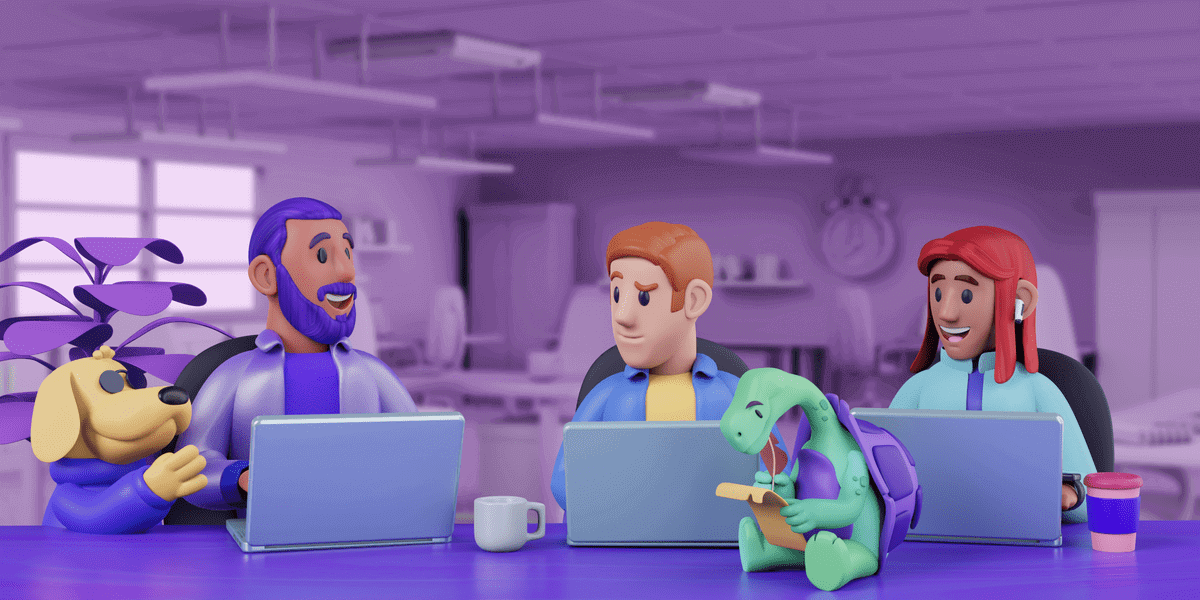
Table of Contents
What do diversity, equity and inclusion mean in workplace communication?
Are the following questions haunting your mind right now:
“What is the difference between diversity and inclusion?” or
“What’s the difference between equity and equality?”
If diversity is the “what”, equity and inclusion are the “how”.
Let’s say diversity is the makeup of your workforce — it consists of employees of different gender, race, age, sexual orientations, etc.
Inclusion is a measure of culture that enables that diversity to thrive. It’s the way you communicate with your colleagues, while taking their different backgrounds into consideration.
Equity is the means of applying inclusion in the workplace — making sure that everyone in your company has the opportunity to prosper and thrive.
If you’re still confused, don’t worry — we’re ready to clear that haze in your brain by clearly defining these terms.
Diversity in communication
Diversity in communication is connected to the language we use to communicate with our coworkers with different backgrounds and experiences to make them feel included and not discriminated against. Bear in mind that this does not only refer to the language you and your coworkers speak, but to the jargon and vocabulary in general, as well as to your choice of wording.
Diversity, in general, is the state of having people of different characteristics in a group or organization.
These characteristics or dimensions of diversity include, among others:
- Culture,
- Ethnicity,
- Gender,
- Language,
- Physical and intellectual ability,
- Race,
- Religion,
- Sexual orientation,
- Socioeconomic status, and
- Age.
Equity in communication
First of all, equity should not be confused with equality.
Namely, equality is giving each member of the group the same resources, regardless of their actual needs or opportunities.
Equity, on the other hand, recognizes that each member of the group has different circumstances and needs, and that they, therefore, need different resources and opportunities in order to thrive.
Long story short — equity means that every employee should be given an equal chance — not the same resources — to succeed.
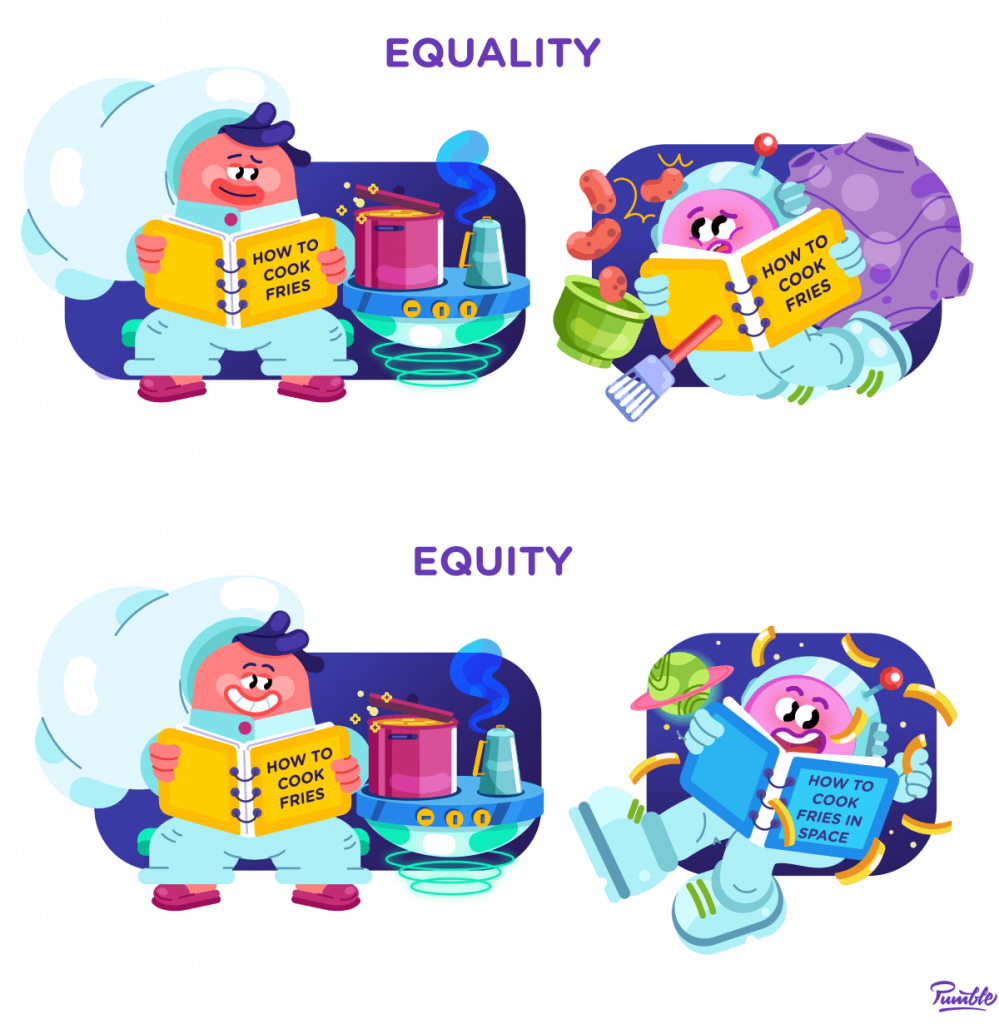
Just as well, communication should be equity-based — meaning that all the employees should be given equal opportunities to participate in conversations, regardless of their dimensions of diversity.
For example, if your coworker is hard of hearing, you should not schedule an audio call with them. Instead, opt for a 1-on-1 meeting or a video call, but only after asking your coworker for their preferences.
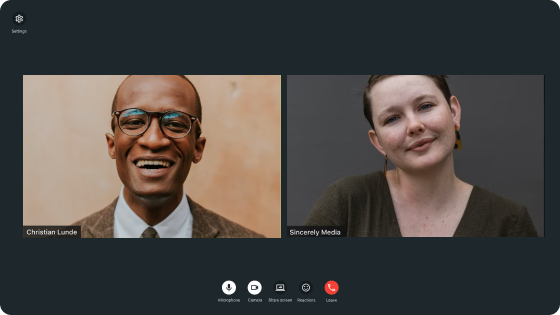
💡 Pumble Pro Tip
Pumble is a free business messaging and video-conferencing tool that helps your team communicate and collaborate. Learn more about what it has to offer here:
Inclusion in communication
Inclusion in communication is one of the greatest drivers of positive employee experience in the workplace.
It encourages employees to voice their opinions and invites every team member to participate and actively contribute to the company’s success.
One of the experts we’ve contacted while researching this topic, Sacha Thompson, an executive coach for DEI practitioners, explained this term further:
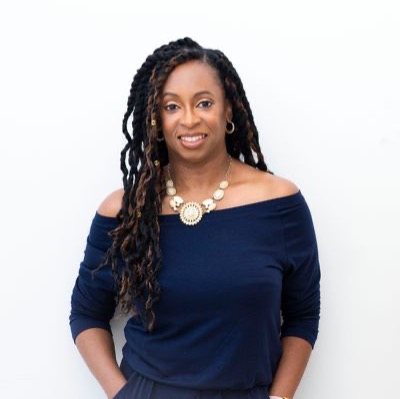
“Inclusive communication, in its purest sense, appropriately addresses as many people as possible in the interaction. It invites all people to feel seen, heard, valued, and respected. Inclusive communication is not just the words we use, but also how we communicate in our body language and actions. It also requires cultural humility — a lifelong commitment to learning about diverse communities, power dynamics and imbalances, and self-evaluating our cultural gaps.”
In other words, inclusive language:
- Makes everyone feel visible in the workplace,
- Inspires us to learn more about other cultures and our coworkers, and
- Enables diversity to thrive.
So, let’s see what inclusive language means in the context of workplace communication.
What is inclusive language in workplace communication?
According to the definition by the Linguistic Society of America, inclusive language:
- Acknowledges diversity,
- Conveys respect to all people,
- Is sensitive to differences, and
- Promotes equal opportunities.
So, to ensure a healthy workplace culture, leaders must incorporate diversity, equity, and inclusion into their communication — both internally (to their employees) and externally (to their stakeholders and clients), by using inclusive language.
Inclusive language in internal communications
Inclusive internal communication has two roles and responsibilities:
- To give each employee a voice and sense of belonging within their organization,
- To inform, educate, and support all employees in adopting inclusive behaviors in every aspect of their working lives.
While researching diversity in communication, we contacted another expert — Beth Castle, managing editor at InHerSight — who shared her view on inclusive language with us:

“When attempting to write inclusive messaging, a lot of companies focus on saying the right thing because they’re afraid of being wrong. In their caution, they opt for vague, directionless language that actually has very little meaning — generic statements about how the company strives to make everyone feel welcome.”
She highlights that awareness shouldn’t keep an organization from saying what they mean and further elaborates on the importance of inclusive language in internal communications:

“Inclusive communication is transparent, honest, authentic, and accountable. It tells employees what companies’ goals are and how they plan to get there. It’s less concerned about saying the perfect thing, and more concerned about saying what needs to be said.”
Inclusive language in external communications
Using inclusive language and honoring diversity in communication should not apply only to internal communication — your external communication should also be inclusive.
More specifically, inclusive language should be used in your external communication — with your customers, clients, and third parties in general, in cases such as:
- Your social media posts,
- Job post descriptions,
- Marketing emails, and
- General customer interactions.
—
Now that we’ve defined diversity, equity, and inclusion, let’s take a closer look at their importance in the workplace.
The importance of diversity, equity and inclusion (DEI) in the workplace
Diversity, equity, and inclusion should not be annoying corporate buzzwords you are obliged to casually drop in your workplace conversations in order to sound more woke.
Studies show that all three rightfully deserve their place in any work environment.
So, let’s take a look at some of the benefits diversity, equity and inclusion bring into a workplace.
DEI improves performance
McKinsey’s 2020 report, Diversity wins: How inclusion matters, shows that the most diverse companies are now more likely than ever to outperform their less diverse peers on profitability.
No matter what type of diversity is analyzed, the results of this research show the same — better performance:
- Companies with more than 30% women executives were more likely to outperform companies where this percentage was smaller.
- Companies with more ethnically and culturally versatile executives outperformed their less diverse competition by 36% in profitability.
DEI breeds innovation and creativity
In any industry, homogeneity almost always leads to a plateau in mindset and performance.
That is why having employees with diverse backgrounds and experiences is the surest way to get unique ideas and solutions.
Research shows that companies that put emphasis on diversity are 1.7 times more likely to be innovation leaders in their market.
Also, more diverse companies are known to be faster at problem solving.
Our contributor Dominic K. Hawkins, Founder and Principal at Factotum Consulting, claims that each and every employee can contribute to an organization in a unique way:

“Each person is capable of leveraging their diverse perspective on an issue, which can prevent an organization from stagnation. When people continue to have the same viewpoints, that can result in slow innovation. Diversity in the workplace also promotes healthy disagreements and coming up with new resolutions to the organization’s challenges.”
Another expert we’ve contacted, Jossie Haines, Executive Coach for Engineering Leaders at Jossie Haines Consulting, agrees that diversity is the best way to curb homogeneous thinking:

“Diverse teams are more innovative and more likely to reduce groupthink and truly build products that fulfill the needs of our diverse world.”
DEI helps organizations reach wider audiences
Research shows that 76% of job seekers consider workplace diversity an important factor when deciding whether to apply for the job.
Furthermore, 32% of job seekers would not apply for a job at a company with a lack of diversity in its workforce.
That being said, it’s easy to conclude that diversity, equity, and inclusion play an important role in attracting new candidates and reaching wider audiences.
Hawkins agrees:

“Another benefit to diversity in the workplace is that diverse perspectives can help organizations reach the audiences that reflect the diversity of their employee base.”
In other words, to attract talent from various demographics, you need to reflect the diversity in your own workforce.
DEI helps fight discrimination
Last, but not least, the diversity, equity, and inclusion initiative is the only ethical option for the modern workplace.
According to the Pew Research Center, by 2065, the US will have no single ethnic or racial majority.
Moreover, according to a 2021 Gallup report, 5.6% of US adults identify as members of LGBTQ+, as opposed to 4.5% in 2017. Also, almost 17% of members of Generation Z identify as LGBTQ+.
However, it’s not about the numbers or statistics.
Simply, embracing diversity, equity, and inclusion is the way to go forward, if we want to end discrimination.
For Castle, all the previously mentioned benefits of diversity, equity and inclusion fade in comparison to the most important one — it’s the right thing to do:

“Companies are made up of people, and people deserve the opportunity to live their best lives. The more we intentionally dismantle barriers to advancement — discriminatory hiring practices, personal biases, etc. — the more inclusive our workplaces become and the closer we get to everyone being granted the rights they, as living, breathing, equal beings, deserve.”
—
As we mentioned before, diversity means nothing without equity and inclusion, and it all starts with communication.
9 Tips for embracing diversity, equity, and inclusion in communication at work
Diversity, equity, and inclusion are not just cliché words used in everyday business lingo, but rather important weapons against discrimination and marginalization of specific groups of people.
It is not enough that organizations practice diversity, equity, and inclusion only in the hiring process, but also in their marketing and communications.
So, here are the tips for embracing diversity, equity, and inclusion in your communication at work.
Tip #1: Be aware of the power of words
According to Kristen Donnelly, PhD, Founder at Abbey Research and a member of the Forbes Business Council, the words we use in workplace communication should be chosen carefully:

“Words are powerful because they are how we express ourselves and create meaning for ourselves in the world. Being a bit more intentional with how we use them in workplace settings is a game changer for company culture.”
Naturally, this is not limited to internal communication.
Our contributor Jossie Haines advises you to be careful with your wording in your external communication as well:

“Inclusive language is crucial and, especially when it comes to job descriptions, we need to focus on this. Terms like rockstar and competitiveness can turn off women, while wording that is too compassionate and collaborative could potentially turn off men.”
Tip #2: Set out standards for inclusive language in all communications
Leaders, HR professionals, and internal communications departments should continuously communicate the benefits of diversity, equity, and inclusion in the workplace.
They should also implement formal policies and procedures for inclusive language in all communications.
Whether in internal or external communication, refrain from using words, phrases, or tones that reflect prejudiced, stereotypical, or discriminatory views of particular people or groups.
Also, you should not exclude people from being seen as a part of a group, deliberately or inadvertently.
One of the most common examples of this inadvertent exclusion is when people use “guys” when addressing a group of people, unaware they are being gender-insensitive.
So, instead of saying “hello, guys!”, say “hello, everyone!”, just like Rose Waters does in Pumble, in the example below.
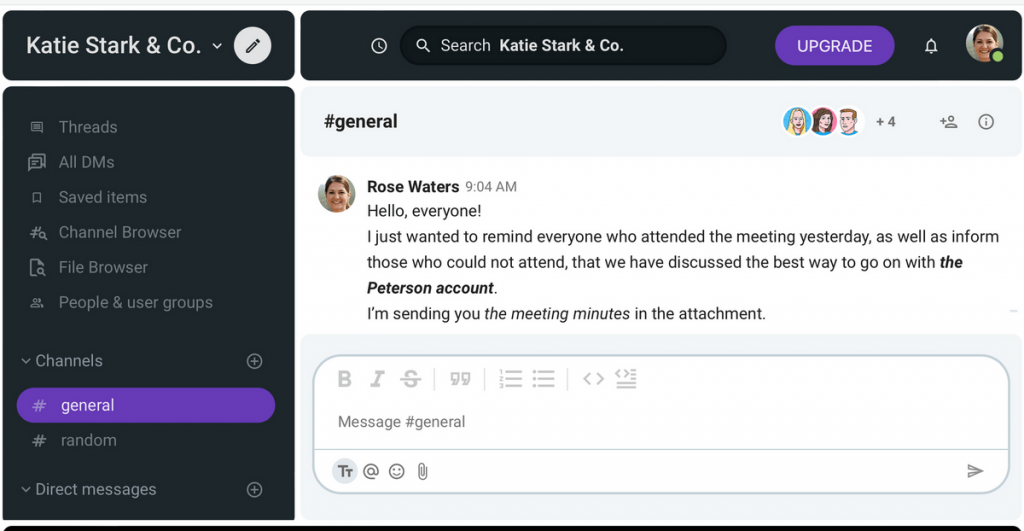
Although some metaphors are historically racist, they are still in use today. However, you should consider replacing them with more neutral terms.
Here are some examples:
| Instead of: | Say: |
|---|---|
| ❌ Blacklist (for malicious websites) | ✅ Exclude or Deny |
| ❌ Whitelist (for safe emails) | ✅ Include or Allow |
| ❌ Black Hat (for malicious hackers) | ✅ Unethical hackers |
| ❌ White Hat (for good developers hacking to make software better) | ✅ Ethical hackers |
| ❌ Master (for main machine) | ✅ Primary machine |
| ❌ Slave (for machines controlled by the main machine) | ✅ Secondary machine |
Tip #3: Understand your own biases
Sometimes, we are not even aware that we are unintentionally hurting others with our words.
These so-called microaggressions communicate some sort of unconscious bias toward historically marginalized groups.
However, they are not to be confused with overt discrimination (or macroaggressions).
In one interview, Kevin Nadal, a professor of psychology at John Jay College of Criminal Justice, explains the difference between the two:
“The difference between microaggressions and overt discrimination or macroaggressions is that people who commit microaggressions might not even be aware of them.”
Let’s illustrate this with an example.
When you ask an American person of color where they’re “really” from, you’re performing a microaggression, and, inadvertently, causing harm to that person.
Such comments can create a tense atmosphere in the workplace, where people from marginalized backgrounds might not feel comfortable.
The solution is to make an inclusive communication strategy and help your employees acknowledge their unconscious biases.
It would allow your employees to better understand and communicate with people from different backgrounds and build an empathic understanding of diverse identities.
This leads us to our next tip.
Tip #4: Embrace authenticity and diversity
Only after we become aware of our unconscious biases, can we embrace our coworkers’ authenticity and our workplace’s diversity.
In other words, we should stop viewing our colleagues as ‘other’, as Hawkins put it.
He elaborates on that:

“Incorporating inclusive language in the workplace begins when people stop viewing different people as ‘other’. We’re all the same people with different characteristics and our language should reflect that. For example, when referring to different races say ‘Black people’ or ‘African-Americans’ not ‘Blacks’. And, saying ‘women’ not ‘females’. If you’re ever uncertain what language to use, it’s OK to ask.”
According to john a. powell*, the director of Othering and Belonging Institute at the University of California, Berkeley, the antonym of “othering” (treating people from another group as different and generally inferior) is “belonging”.
* john a. powell spells his name in lowercase in the belief that we should be “part of the universe, not over it, as capitals signify”.
So, make your coworkers feel they belong, instead of feeling like others.
Let’s illustrate this with an example:
Timothy chalmers is a DEI consultant in a large company. Since the holiday season is approaching, he is checking with his coworkers about which holidays they are celebrating, so everyone can take a day off and enjoy themselves with their family.
Nothing is implied and no one is discriminated against.
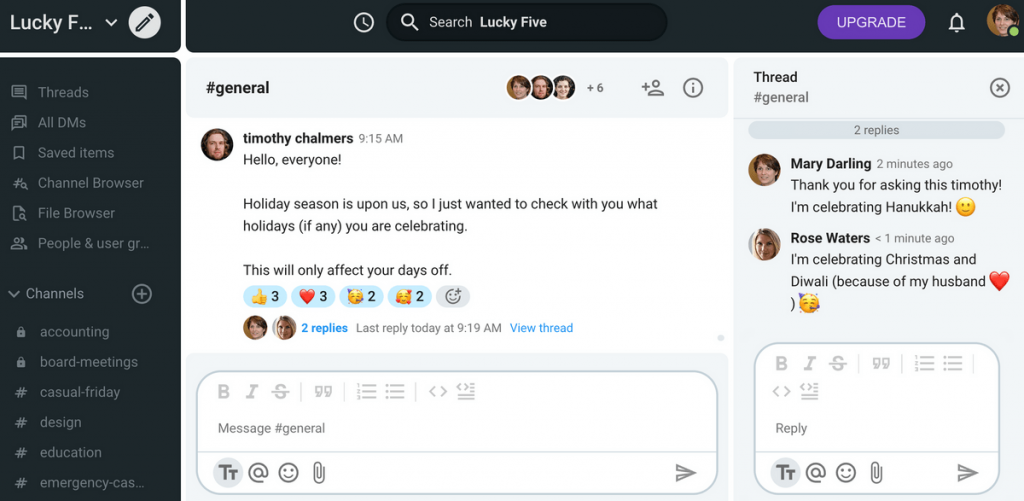
Tip #5: Actively listen and ask questions
If you’re not sure whether you should use a certain term and are afraid that someone might get offended by it, just ask your coworkers if it’s OK.
Don’t just copy and paste generic statements just to formally tick a corporate box.
Instead, talk to your colleagues about anything you’re confused about when workplace communication is concerned.
A real discussion about why your company is embracing the diversity, equity and inclusion initiative is more than welcome.
Only when you ask the right questions and actively communicate with your colleagues can you successfully implement your DEI initiative.
For Castle, the best way to promote diversity, equity and inclusion in workplace communication is to actively listen to your colleagues:

“Step one is listening — always. You have to sit with different perspectives and really understand what people need to feel seen and supported because it might not be what you expect. Then act and communicate as you do. Show people that you heard them and that you’re actually doing something about it.”
For instance, you could ask your employees and coworkers how they identify themselves.
Let’s look at an example:
Rose Waters is an HR specialist in a marketing company. She would like to address her colleagues in their preferred way, so she’s asking them to add their preferred pronouns next to their names. She leads by example but isn’t forcing anyone to do anything they might feel uncomfortable with.
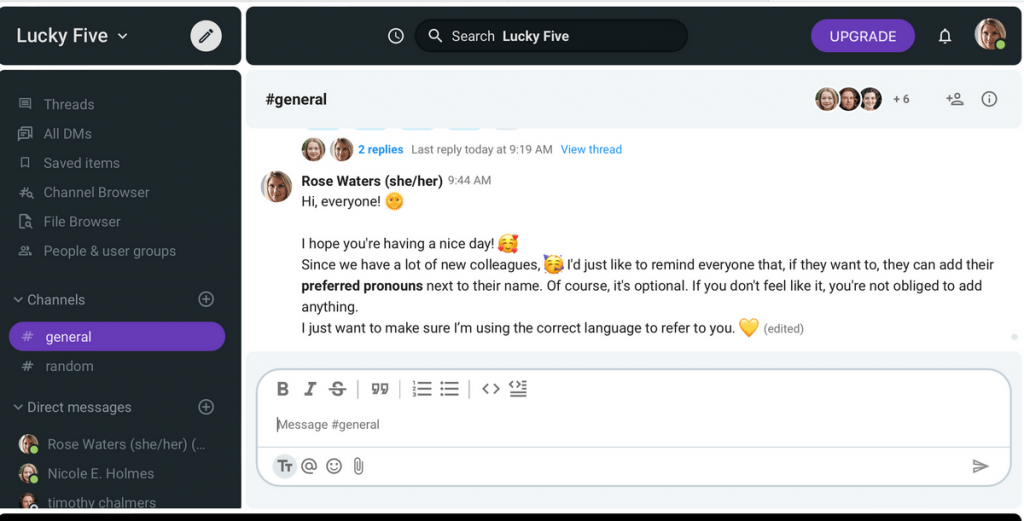
Tip #6: Focus on building trust
Another expert we’ve contacted, Dr. Aditi Paul, a communication strategist and an associate professor at Pace University in New York, emphasized that it all starts with representation. The more representative the teams in a corporation, the higher the chances that the teams will have sensitivity toward a broader audience.
Aside from that, she highlighted another important factor for an inclusive workplace:

“Together with representation, the corporation should foster a culture of psychological safety whereby employees feel safe to bring up matters of discomfort, harassment, and exclusion without any fear of retribution.”
In other words, you should work on building trust with your employees, so they can feel free to express themselves and achieve their full potential.
Tip #7: Promote policies and initiatives
Necessary conditions for having open conversations are to make sure that everyone is aware of:
- Company position on DEI matters,
- The expectations placed upon them, and
- The vision they are working towards.
In the example below, Katie Stark is sharing her company’s DEI policy with her team, just as she announced in a virtual meeting they previously had.
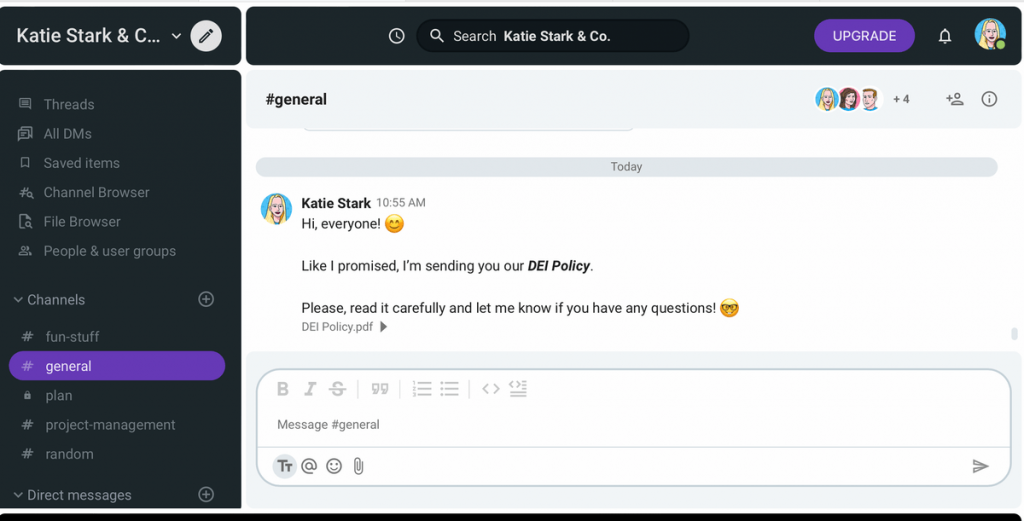
To make sure everyone is on the same page when it comes to DEI, our contributor Dr. Aditi Paul has a simple piece of advice:

“Bake the initiative into policies.”
Aside from that, your HR team should make sure that diversity, equity, and inclusion are embedded in your recruitment and onboarding communications.
Tip #8: Engage with external events
Another useful tip for promoting diversity, equity, and inclusion in your workplace communication is to incorporate significant days for your employees in your internal communications calendar.
For instance, show your coworkers that you care about them, by raising awareness among employees of why people may be fasting during Ramadan.
To increase understanding and tolerance among your employees, you can also participate in external events, such as awareness days and events such as Pride or Black History Month.
In the example below, Doris Hustvedt is announcing that their company will change its logo to celebrate diversity and show support for the LGBTQA+ population.
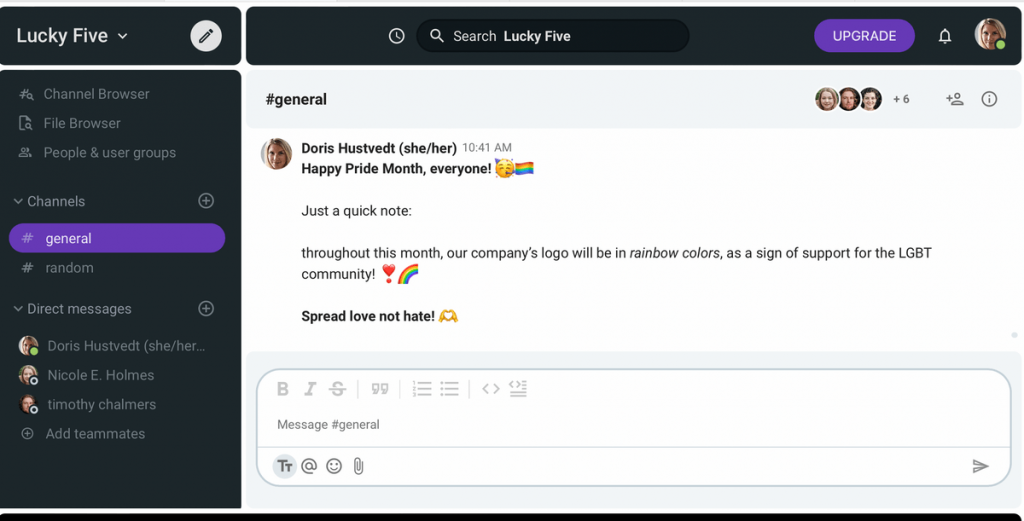
Tip #9: Model the behavior you would like to see
Finally, none of the tips mentioned above matter if you’re not ready to practice what you preach.
It’s not enough to infuse your marketing and communication channels with empty words about diversity if you’re not ready to walk the walk.
Thompson also suggests behaving as you want others to behave as one of the most effective ways to truly promote DEI:

“One of the most powerful ways to promote diversity and inclusion is to model the behavior you would like to see. If you are setting up a meeting for a project, ask:
- Does this team represent a cross-section of our client base?
- What perspectives are missing from this group?
- Could the outcome of this project be exclusionary in any way?
Those questions will create space to slow down and ensure everyone involved and those impacted by the work feel valued, seen, and heard.”
If you’re not satisfied with the current level of diversity in your company, don’t worry. Just keep on walking this path, step by step, and you’ll reach your goal.
Pumble: The perfect place for inclusive professional communication
As you have seen above, the benefits of diversity, equity, and inclusion in both the workplace and workplace communications are manifold which is why your DEI initiatives shouldn’t be there just so you can check a corporate box.
Picking your words and setting standards for inclusive language might be vital for your organization.
Luckily, with Pumble, a team communication app, it will be easier to not only embrace but also carry out your DEI initiatives. Thanks to its various features, Pumble users can always choose the right communication channel to connect with their colleagues:
- If you want to communicate with a particular colleague, you can direct message them without worrying about the security of the messages or files you send.
- If you want to include other colleagues in your conversation, you can create group direct messages or channels.
- You can schedule video or audio calls whenever it suits you — of course, as we said above, they should be arranged only when it suits everyone.
- You can create a more inclusive workspace and give your colleagues permission to post on different channels and ensure everyone has an equal opportunity to speak up.




